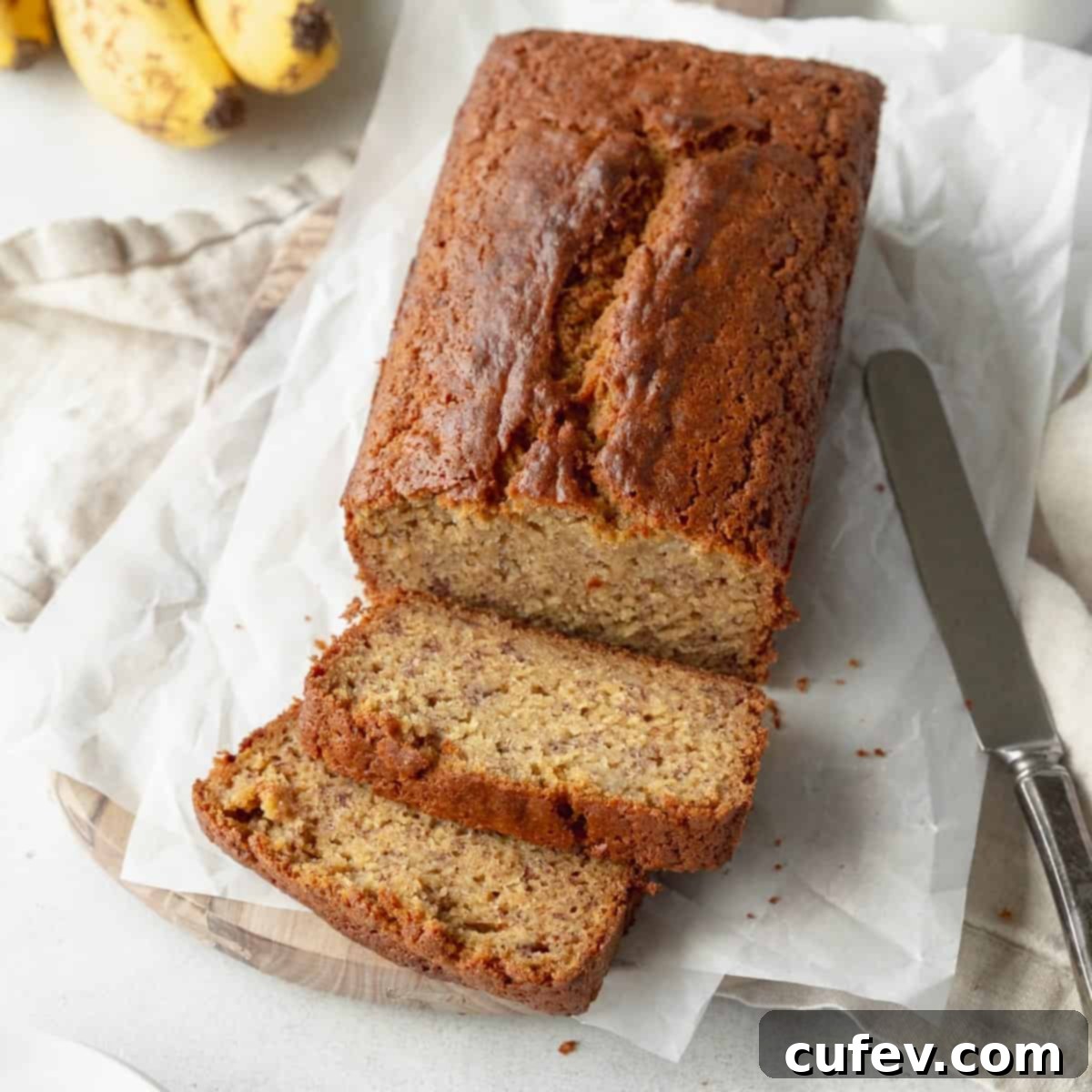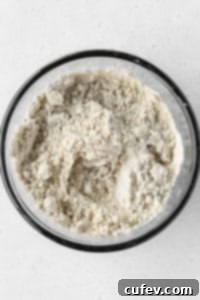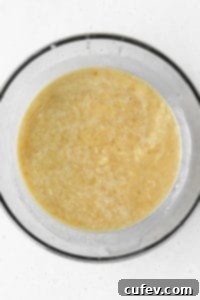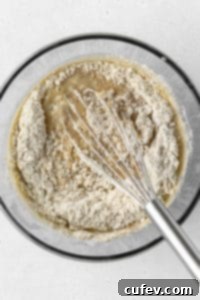The Ultimate Gluten-Free Banana Bread: Perfectly Moist, Sweet, and Effortlessly Easy
Craving a slice of comforting, incredibly moist banana bread but need it to be gluten-free? Look no further! This recipe delivers a perfectly sweet, intensely banana-flavored loaf that will satisfy every craving. Thanks to a generous amount of overripe bananas, each bite is bursting with natural sweetness and a tender crumb. It’s an astonishingly easy recipe to follow, making it ideal for both novice and experienced bakers alike. In our home, this delightful treat never lasts more than a day or two – it’s simply irresistible!

This beloved recipe was originally shared on February 24, 2022. It has since been meticulously updated on January 16, 2024, with enhanced recipe information, clearer instructions, and fresh new photos to ensure your baking success and an even more delightful experience.
Essential Ingredients for Your Perfect Gluten-Free Banana Bread
Creating this outstanding gluten-free banana bread requires a selection of simple, readily available ingredients. Each component plays a crucial role in achieving the desired moist texture, rich flavor, and beautiful rise. Here’s a detailed look at what you’ll need:
Gluten-free 1-to-1 flour – This is often labeled as gluten-free “measure for measure” flour, designed to substitute traditional wheat flour in equal amounts. It’s vital that your chosen blend already contains xanthan gum, as this acts as a binder, providing structure and elasticity that gluten typically offers. My personal favorite and highly recommended option is this blend, known for its consistent results in gluten-free baking. Using a reliable 1-to-1 blend simplifies the process and guarantees a fantastic texture.
Salt – A crucial flavor enhancer in any baked good. Use fine salt for even distribution throughout the batter. I prefer fine Himalayan salt for its subtle mineral notes, but fine sea salt is an excellent alternative. Salt balances the sweetness and brings out the deep banana flavor.
Baking soda & baking powder – This recipe smartly utilizes a combination of both these leavening agents. Baking soda reacts with acidic ingredients (like brown sugar and apple cider vinegar) to create lift and a tender crumb, while baking powder provides additional lift and helps stabilize the structure, ensuring your banana bread rises beautifully and is wonderfully airy.
Unsalted butter – Starting with unsalted butter gives you complete control over the total salt content in your gluten-free banana bread. If your only option is salted butter, remember to reduce the amount of added salt by half to prevent an overly salty outcome. For those seeking a dairy-free option, high-quality vegan butter can be seamlessly substituted, yielding a delicious dairy-free banana bread.
Granulated sugar & brown sugar – The thoughtful combination of these two sugars is key to this recipe’s success. Granulated sugar provides pure sweetness and helps achieve a tender texture. Brown sugar, with its molasses content, contributes a deeper sweetness, exceptional moisture, and a rich, irresistible toffee-like flavor that complements the bananas beautifully.
Eggs – Always use large eggs for this recipe. Eggs are multifunctional in baking: they add significant moisture, act as a binding agent, contribute to the structure, and help with the overall rise of the bread, resulting in a perfectly tender and cohesive loaf.
Bananas – The star of the show! It’s absolutely crucial to use overripe bananas. Look for bananas with abundant brown spots or even entirely brown skins. These bananas are much sweeter and softer, making them easier to mash and imparting that intensely delicious, concentrated banana flavor we all adore in banana bread. They might be too ripe to enjoy on their own, but they are absolutely perfect for baking!
Apple cider vinegar – While it might seem like an unusual addition, an acidic ingredient like vinegar is essential to activate the baking soda, ensuring your bread rises properly and achieves a light texture. Don’t skip it; it’s a small but mighty component that makes a big difference!
Milk – Any kind of milk will work here. Feel free to swap it out for your preferred non-dairy milk (almond, soy, oat, etc.) if you desire a dairy-free loaf. You can also use buttermilk for an extra tender crumb and tangy flavor, but if you do, omit the apple cider vinegar as buttermilk is already acidic.
Vanilla – A teaspoon of pure vanilla extract or vanilla paste enhances all the other flavors, adding a warm, aromatic depth that makes the banana bread even more inviting and delicious.
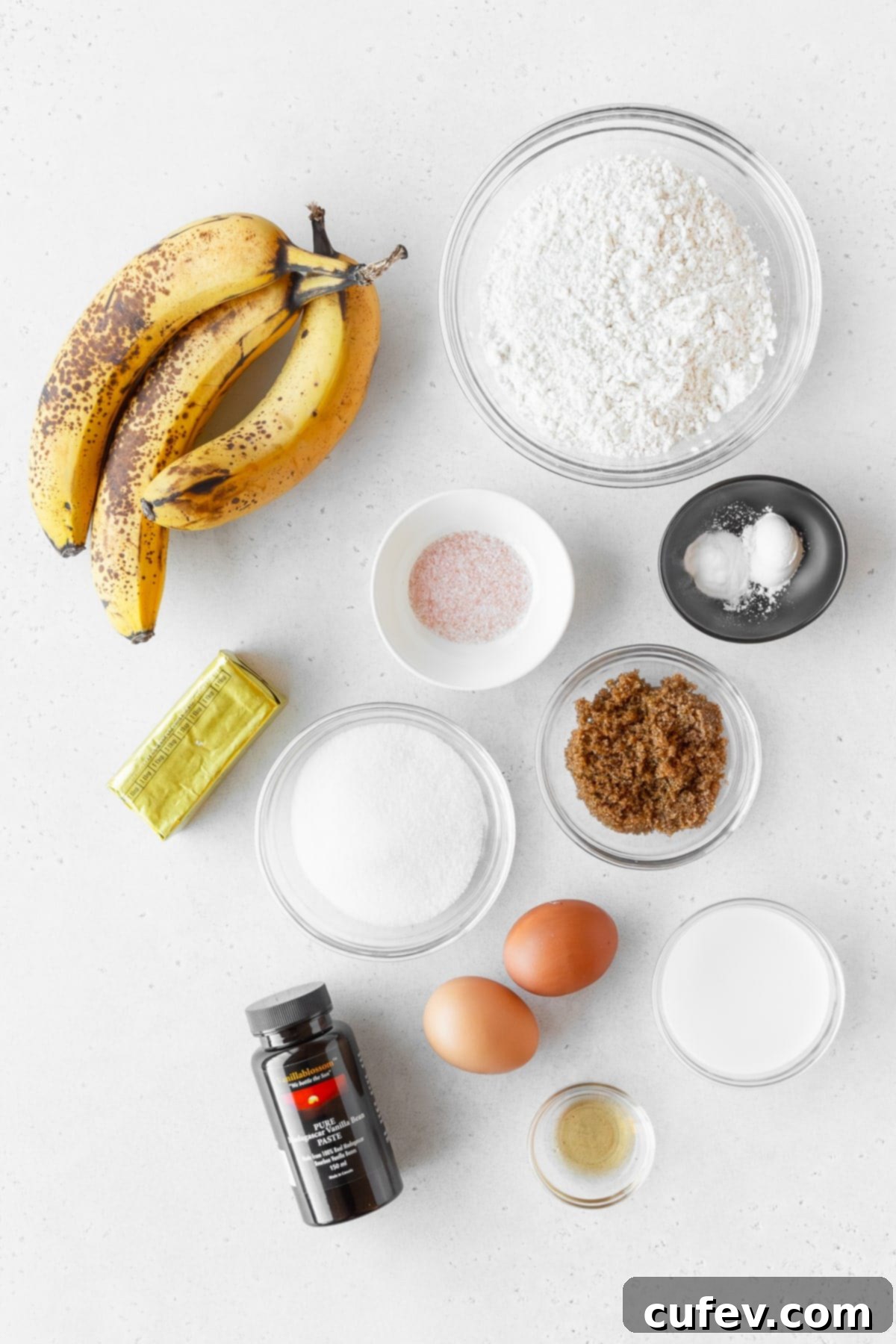
Expert Tips for Baking Your Best Gluten-Free Banana Bread
Achieving a consistently amazing gluten-free banana bread is simple when you know a few key tricks. Follow these tips to ensure every loaf you bake is perfectly moist, flavorful, and has that coveted tender crumb:
Room temperature ingredients are a must. This isn’t just a suggestion; it’s crucial for optimal results. Ingredients like butter and eggs at room temperature emulsify better, meaning they blend together more smoothly and uniformly. This creates a more cohesive and evenly textured batter, which translates to a lighter, fluffier, and more consistent baked bread. Pull them out of the fridge at least 30 minutes to an hour before you plan to start baking.
Always use unsalted butter. Employing unsalted butter provides you with precise control over the sodium content in your gluten-free banana bread. Different brands of salted butter contain varying amounts of salt, making it difficult to predict the final taste. If unsalted butter isn’t available, or if you’re opting for vegan butter (which is often salted), make sure to reduce the amount of salt called for in the recipe by half. This adjustment prevents your delicious bread from becoming overly salty and ensures a balanced flavor profile.
Rest your batter for a superior texture. This is a game-changer for gluten-free baking! After combining your wet and dry ingredients, cover the bowl and let the batter rest for at least half an hour. This resting period allows the gluten-free flour to fully hydrate, absorbing the liquids properly. Without this crucial step, gluten-free baked goods can sometimes develop a slightly gritty or crumbly texture. Hydration also helps the starches gel, leading to a smoother, more tender, and less dense final product.
Don’t overmix the batter. While resting is important, overmixing is the enemy of tender baked goods, especially in gluten-free recipes. Mix the wet and dry ingredients just until combined and no streaks of dry flour remain. Overmixing can develop any inherent gumminess in the gluten-free flour blend and result in a tough or dense loaf.
Draw a line on the batter for a beautiful dome. Ever wondered how professional bakers achieve those perfectly domed loaves with a beautiful split down the center? It’s a simple trick! After you’ve poured your rested batter into the prepared loaf pan, take a butter knife and gently insert it about an inch deep into the batter. Draw a vertical line right down the center of the loaf. As the banana bread bakes, this scored line acts as a guide, allowing the bread to expand evenly upwards and create that aesthetically pleasing, professional-looking crack.
Cool completely before slicing. This step requires patience, but it’s absolutely vital for the best results. Gluten-free baked goods, much like their gluten-containing counterparts, continue to “bake” and set as they cool. Slicing into a warm loaf, no matter how tempting (and believe me, I understand the temptation!), will result in a mushy texture and a less developed flavor. The bread needs time to firm up and allow its internal structure to stabilize. For the best taste and texture, wait until the loaf is completely cool to the touch before cutting and serving.
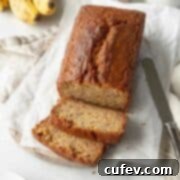
Gluten-Free Banana Bread Recipe
Print
Pin
Rate
Ingredients
- 1½ cups gluten-free 1-to-1 flour
- 1 teaspoon fine salt
- ½ teaspoon baking soda
- 1 teaspoon baking powder
- ⅓ cup unsalted butter softened at room temperature
- ½ cup granulated sugar
- ¼ cup brown sugar
- 2 large eggs
- 1 cup mashed bananas (about 3 very overripe large bananas)
- 1 teaspoon apple cider vinegar
- ¼ cup milk
- 1 teaspoon pure vanilla extract
- 1 cup chocolate chips, chopped walnuts, or other mix-in (optional, but highly recommended!)
Instructions
-
In a medium-sized bowl, thoroughly whisk together the gluten-free flour, fine salt, baking soda, and baking powder until well combined. Set this dry mixture aside.

-
In a separate, larger bowl, using an electric mixer or whisk, cream together the softened unsalted butter, granulated sugar, and brown sugar until the mixture is light and fluffy. Add the large eggs one at a time, beating well after each addition to fully incorporate them.
-
Gently stir in the mashed overripe banana, apple cider vinegar, and milk until just combined. The mixture might look a little lumpy due to the bananas, which is perfectly normal.

-
Gradually add the reserved dry flour mixture to the wet ingredients. Mix on low speed or by hand until you no longer see any visible bits of dry flour. Be careful not to overmix! If adding any optional mix-ins like chocolate chips or chopped walnuts, gently fold them in now. Cover the batter and let it rest at room temperature for 30 minutes. This resting period is crucial for the best gluten-free texture.

-
While the batter rests, preheat your oven to 350°F (180°C). Prepare an 8.5 x 4.5 inch loaf pan by greasing it lightly and lining it with parchment paper, leaving an overhang on the sides for easy removal.
-
Pour the rested banana bread batter evenly into the prepared loaf pan. Bake in the preheated oven for 65-70 minutes, or until a wooden skewer inserted into the center comes out clean. If the top browns too quickly, you can loosely tent it with aluminum foil. Once baked, let the loaf cool in the pan for 10-15 minutes before transferring it to a wire rack to cool completely. This final cooling step is essential for proper setting and achieving the perfect texture.

Nutrition
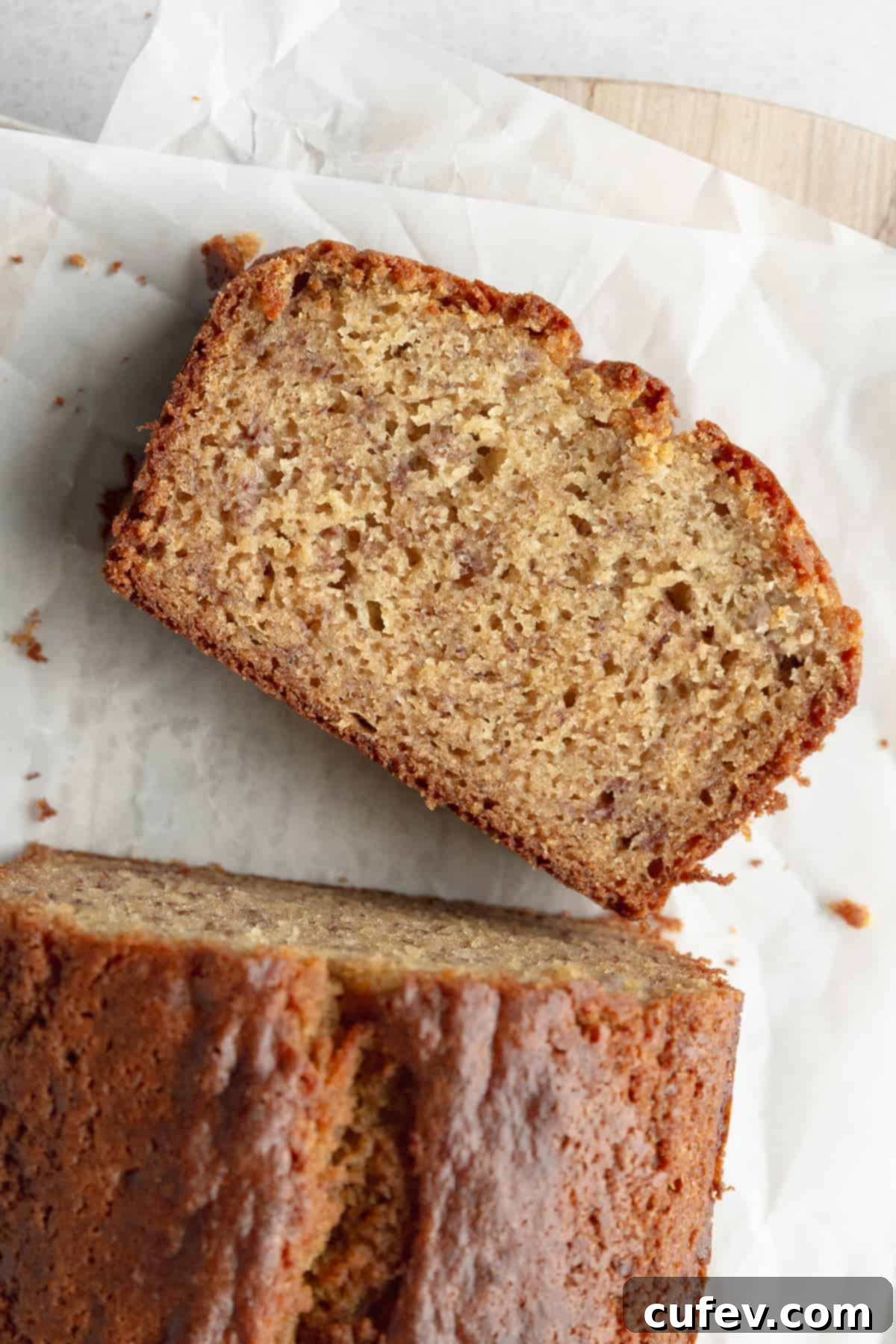
Storage and Freezing Directions for Your Delicious Loaf
To keep your gluten-free banana bread fresh and delicious for as long as possible, proper storage is key. Whether you plan to enjoy it over a few days or save some for later, here’s how to store it effectively:
Storing: To maintain its optimal moisture and prevent it from drying out, it’s best to store your banana bread in an airtight container at room temperature. It will stay fresh and moist for up to 3 days. A crucial tip for extending its freshness: avoid slicing the entire loaf all at once. Instead, only slice off the amount you plan to eat in a single sitting. This keeps the exposed surface area to a minimum, preserving the internal moisture of the remaining loaf.
Freezing: Banana bread freezes beautifully, making it perfect for meal prep or enjoying a homemade treat whenever a craving strikes. For best results, allow the loaf to cool completely before freezing. Then, wrap each individual slice tightly with plastic wrap. This extra layer of protection helps prevent freezer burn and maintains the bread’s texture. Place the wrapped slices into a freezer-safe bag or an airtight container and store them in the freezer for up to a month. To defrost, transfer the desired number of slices to the refrigerator overnight. Once thawed, bring them to room temperature on the counter for about 15-30 minutes before enjoying, or gently warm them in a toaster oven for a freshly baked feel. Avoid thawing directly at room temperature from frozen, as this can lead to excessive condensation and a soggy texture.
Frequently Asked Questions About Gluten-Free Banana Bread
For this particular recipe, a gluten-free “measure for measure” or “1-to-1” flour blend is highly recommended. These blends are formulated to seamlessly replace wheat flour cup-for-cup in most recipes, simplifying the conversion process. I have successfully tested this recipe with two specific and reliable flour blends: Bob’s Red Mill Gluten Free 1-to-1 Baking Flour and Cup4Cup Wholesome Flour. While I can’t guarantee results for every single blend on the market, most reputable 1-to-1 blends should work well. The critical factor is to ensure that your chosen blend contains xanthan gum. Xanthan gum is an essential ingredient in gluten-free baking, acting as a binder and providing the necessary structure and elasticity that gluten would normally contribute, preventing a crumbly or dry texture.
Absolutely! Adding mix-ins is a fantastic way to customize your gluten-free banana bread and introduce exciting textures and flavors. I personally adore making this into gluten-free chocolate chip banana bread by adding a full cup of delicious chocolate chips – they melt into gooey pockets of flavor. Chopped walnuts or pecans are also wonderful additions, providing a delightful crunch and nutty flavor that complements the sweet banana. Feel free to experiment with other favorites like dried cranberries, shredded coconut, or a swirl of cinnamon sugar for endless variations!

While almond flour is a popular gluten-free alternative, substituting the entire amount of the 1-to-1 flour blend with almond flour will significantly impact the final texture and structure of this banana bread. Almond flour behaves very differently due to its high fat content and lack of binding proteins. Although I haven’t personally experimented with a full almond flour substitution for this specific recipe, I would advise against it for optimal results. If you wish to incorporate almond flour, I suggest only substituting up to ½ cup of the measure-for-measure flour with almond flour. Be aware that even this partial substitution may result in a slightly denser loaf that might not rise quite as well as the original recipe. The texture will likely be different, potentially more cake-like or fudgy, but still enjoyable if you adjust your expectations.
Unfortunately, this particular recipe is not easily adaptable to be fully vegan. The two large eggs play a very critical role in this banana bread, contributing significantly to its rise, overall structure, and essential moisture. Replacing them with a standard egg substitute would likely compromise both the delicious flavor and the tender texture that makes this recipe so exceptional. While some vegan banana bread recipes exist, they are formulated differently to account for the absence of eggs and dairy. For a reliable vegan banana bread, it’s best to seek out a recipe specifically developed to be vegan from the start.
Absolutely, banana bread batter can often be converted into muffins! However, for truly perfect, moist, and fluffy gluten-free banana muffins, I highly recommend using my dedicated gluten-free banana muffin recipe instead. That recipe is specifically formulated to yield the ideal muffin texture and dome, which can be slightly different from a loaf. The baking times and pan preparation will also differ, so using a tailored muffin recipe will ensure the best results every time.
The riper your bananas, the better your banana bread will taste! You want bananas that are beyond appealing for fresh eating. Look for skins that are extensively speckled with brown spots or have turned almost entirely brown or black. The flesh inside should be very soft and easily mashable with a fork. Green or even firm yellow bananas won’t provide the necessary sweetness or moisture, resulting in a less flavorful and potentially drier bread. If your bananas aren’t quite ripe enough, you can speed up the process by baking them in their skins on a baking sheet at 300°F (150°C) for 15-30 minutes until they are soft and black.
Explore More Delicious Banana Recipes from Our Kitchen
If you’ve fallen in love with the comforting flavor of bananas in baked goods, you’re in for a treat! Our kitchen is brimming with even more incredible banana-inspired recipes to satisfy every craving. Whether you prefer classic loaves or creative desserts, there’s something here for everyone.
Can’t get enough of rich, moist banana bread? Be sure to try my highly-rated recipe for classic banana bread made with cake flour, which boasts an unbelievably tender crumb. For chocolate lovers, my indulgent double chocolate banana bread is an absolute must-make, combining the richness of cocoa with sweet banana. (And while not banana bread, my gluten-free zucchini bread consistently receives rave reviews from friends and family for its exceptional moistness and perfect blend of warming spices – a truly delicious way to enjoy your vegetables!)
If you’re looking for delightful breakfast or brunch-appropriate recipes, start your day right with my fluffy and flavorful gluten-free banana pancakes with chocolate chips, or grab a convenient and wholesome bite with my chewy peanut butter banana oatmeal bars.
For those who adore banana desserts, our vegan banana cupcakes and equally delightful vegan chocolate banana cupcakes are absolute must-makes. They prove that you don’t need dairy or eggs to create incredibly moist and flavorful treats!
And if you’re searching for something easy to prepare but undeniably impressive, you simply have to make this stunning banana coconut upside-down cake. It’s a showstopper that tastes as incredible as it looks, perfect for special occasions or just to brighten any day.
